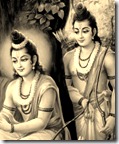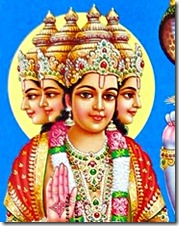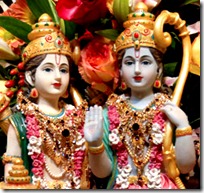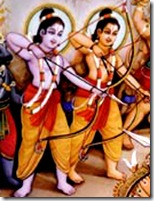 “After Brahma created them, there was no beauty left for the rest of the world. If you searched the entire fourteen bhuvanas you wouldn’t find anything that could compare to their beauty.” (Janaki Mangala, Chand 4.1) “After Brahma created them, there was no beauty left for the rest of the world. If you searched the entire fourteen bhuvanas you wouldn’t find anything that could compare to their beauty.” (Janaki Mangala, Chand 4.1)
birace biraṃci banāi bām̐cī rūciratā rancau nahīṃ |
dasa cāri bhuvana nihāri dekhi bicāri nahiṃ upamā kahīṃ ||
There are fourteen planetary systems in each universe. With innumerable universes, we get an idea of just how unlimited the material creation is. In each sphere Lord Brahma is tasked with creation, with developing the material nature to act as the playing field for the bodies of the many living entities who make up the population. The spirit souls exist eternally, so Brahma has no powers of creation on the spiritual side. Depending on their desires, if they should so choose to leave the constitutional area of the spiritual sky, they get to roam in a land that has a temporary manifestation. For those who don’t know better, Brahma is considered the master behind all the manifestations of matter. Therefore when looking at two handsome youths, sons of King Dasharatha, the only thought that could be made was that Brahma ran out of beauty. There was none left after the bodies for these two boys were made. Hence the rest of the world became bereft of splendor and beauty, a fact noted instantly by gazing upon these two handsome princes.
 The fourteen planetary systems don’t all have the same environment. There are varying levels of enjoyment with the many systems, which accounts for the distinctions between heaven, earth and hell. The heavenly planets are in the upper portion. The residents there live for long durations of time in comparison to the residents of the earthly planet. Heaven brings enhanced enjoyment, but which is still temporary. The earthly planet has a mix of heavenly and hellish life, and the lower planets are reserved for the most sinful. Regardless of the residence, the occupants are part of a temporary stay, though through attachment to the matter shaped and molded by Lord Brahma forgetfulness of mortality arises. The fourteen planetary systems don’t all have the same environment. There are varying levels of enjoyment with the many systems, which accounts for the distinctions between heaven, earth and hell. The heavenly planets are in the upper portion. The residents there live for long durations of time in comparison to the residents of the earthly planet. Heaven brings enhanced enjoyment, but which is still temporary. The earthly planet has a mix of heavenly and hellish life, and the lower planets are reserved for the most sinful. Regardless of the residence, the occupants are part of a temporary stay, though through attachment to the matter shaped and molded by Lord Brahma forgetfulness of mortality arises.
The mention of the fourteen planetary systems in the above referenced verse from the Janaki Mangala is made to try to accurately convey just how beautiful Rama and Lakshmana were as they were departing Ayodhya for the forest with Vishvamitra Muni. Lord Rama is the Supreme Lord in the guise of a warrior prince and Lakshmana is His chief companion, the servitor-God. The Supreme Lord is the father of even Brahma, so there is no question of any of His bodies ever being created. Lord Brahma crafts the forms of the conditioned living entities based on their past karma, but the system of fairness taking into account action and reaction does not apply to God.
Lakshmana is a Vishnu-tattva expansion, so He too does not have a material body. Rama is of the darker, orshyama, color, while Lakshmana is gaura, or fair. To enhance the delight of the fortunate souls with whom they associated, Shri Rama and Lakshmana masked their divine identities. It was not known to everyone that they were God. With the Supreme Lord’s personal self, the brilliant features cannot be masked fully. I may not know what gold is as a young child, but if I see it sparkling in front of me, I will still be enamored by it. I may not know what sweets and chocolates are, but if I eat them, I will still enjoy the wonderful taste.
In a similar manner, those sinless souls who are blessed with the company of Rama and Lakshmana may not know that they are the Supreme Lord and His number one servant, but through the association they enjoy the brilliant features nonetheless. Through Rama’s potency ofyogamaya the mind starts to wonder just where a splendid body like that could come from. The comparison to Lord Brahma and the fourteen worlds is brilliant because the hidden meaning is that Rama and Lakshmana are not of this universe. You could search through every inch of space, look at every living entity and their temporary manifestation, and still not find anyone who could compare to the beauty of the two youths.
 Why is it important to mention this fact? The purpose of the Janaki Mangala is to provide transcendental enjoyment, to both the author and the listeners. The preacher gets so much enjoyment out of discussing the glories of the Supreme Lord. Since His features are inexhaustible in their endurance, the opportunities for glorification never cease. The spirit soul, the essence of identity, has inherent characteristics. Rather than try to decipher these on our own through the tedious process of elimination, we can take it on the authority of the Vedas that the soul is eternal, knowledgeable and blissful. Only something that is knowledgeable from the start can do complex math and think rationally after receiving proper training. Only something that is inherently blissful can feel happiness through association and activities that speak to its inherent tendencies. Why is it important to mention this fact? The purpose of the Janaki Mangala is to provide transcendental enjoyment, to both the author and the listeners. The preacher gets so much enjoyment out of discussing the glories of the Supreme Lord. Since His features are inexhaustible in their endurance, the opportunities for glorification never cease. The spirit soul, the essence of identity, has inherent characteristics. Rather than try to decipher these on our own through the tedious process of elimination, we can take it on the authority of the Vedas that the soul is eternal, knowledgeable and blissful. Only something that is knowledgeable from the start can do complex math and think rationally after receiving proper training. Only something that is inherently blissful can feel happiness through association and activities that speak to its inherent tendencies.
In the same way, only something that is eternal in its existence can continue to remain vibrant through the cycle of birth and death, the constant acceptance and rejection of bodies. The spirit soul is the same in quality when it is in the pea-like body within the womb as it is when it is in the body of a fully matured adult. The best way for the soul to seek happiness is to find an engagement that meets its natural characteristics. That internal bliss is found through service, which is ideally directed at the Supreme Lord. Rama is meant to be served and the numerous sparks of spirit are meant to provide the service.
Shri Lakshmana is always in a devotional mood because he never breaks from the divine consciousness. He then passes on the wisdom necessary for accepting that mood of service with confidence to the people he teaches. The spiritual master of the Vedic tradition, the guru, is Lakshmana’s representative. In the Janaki Mangala, we get an idea of how glorious Rama and Lakshmana are, and at the same time we are given an outlet for extending our service to God. We may be very rich or very poor, but in either case there is the same opportunity to serve the Supreme Lord and feel happiness.
The devotee sacrifices their time and effort in composing poetry and sharing it with others, and the consuming public lends their ears to these works, basking in the sweetness of the words and the mental pictures they paint. The image of Shri Rama and Lakshmana escorting Vishvamitra, the son of Gadhi, into the dangerous forests is a pleasure for the consciousness, which needs a vital source of happiness while residing in a land full of bewilderment furthered by constant creation and destruction.
 Why was the forest dangerous? A band of night-rangers, headed by Maricha, was wreaking havoc, disrupting the sacrifices of the brahmanas, the priestly class. Think of a priest delivering a sermon in church on Sunday when a terrorist comes in and blows everything up. A similar thing was happening in the forest of Dandaka, where many ascetics had sought refuge because of the peaceful surroundings. Rama and Lakshmana were sons of King Dasharatha, so they were trained from birth to protect the innocent. Dasharatha did not want to part with Rama, but Vishvamitra insisted that only Rama could protect him. Thus the two beautiful sons left their comfortable home to reside in the austere settings of the forest. Not once did they complain nor did they fail to uphold their responsibilities. Vishvamitra, pleased with them, gave the boys mantras to be used when fighting. Rama and Lakshmana don’t need any help from anyone, but so great is their respect for the priestly class that to boost the stature of figures like Vishvamitra they pretend to require help. Why was the forest dangerous? A band of night-rangers, headed by Maricha, was wreaking havoc, disrupting the sacrifices of the brahmanas, the priestly class. Think of a priest delivering a sermon in church on Sunday when a terrorist comes in and blows everything up. A similar thing was happening in the forest of Dandaka, where many ascetics had sought refuge because of the peaceful surroundings. Rama and Lakshmana were sons of King Dasharatha, so they were trained from birth to protect the innocent. Dasharatha did not want to part with Rama, but Vishvamitra insisted that only Rama could protect him. Thus the two beautiful sons left their comfortable home to reside in the austere settings of the forest. Not once did they complain nor did they fail to uphold their responsibilities. Vishvamitra, pleased with them, gave the boys mantras to be used when fighting. Rama and Lakshmana don’t need any help from anyone, but so great is their respect for the priestly class that to boost the stature of figures like Vishvamitra they pretend to require help.
The devotees have limited abilities in the area of glorification, but the kind Lord pays more attention to sincerity than to the end result. What can we really create anyway? Lord Brahma is much more powerful than we are, for he is responsible for the 8,400,000 different species that appear in the fourteen worlds. Despite his abilities to create, there is no beauty available on his massive palette of qualities to create something comparable to Rama or Lakshmana.
You could search the entire fourteen worlds and not find anything like those two youths. Similarly, you can scour the whole of literature, spiritual or otherwise, and not find anything as sweet and heartwarming as the works crafted by Goswami Tulsidas, the author of the Janaki Mangala. Because he was selfish enough to want to bask in the sweet vision of Rama and Lakshmana with Vishvamitra, we are today fortunate enough to have the same mental image painted for us.
In Closing:
Beauties like Rama and Lakshmana never seen,
Anywhere in the planetary systems fourteen.
Leaving with Vishvamitra such a pleasurable sight,
The two boys who bring to Raghu’s clan delight.
Tulsidas in attempt to keep vision in mind,
Wrote many poems, allows for time to rewind.
Brahma must have used materials the best,
All beauty used up, none left for creatures the rest.
Of course no creation, God’s body and soul the same,
Comparison attempt for unexplainable to explain.
|
Search This Blog
Tuesday, March 27, 2012
Two Handsome Boys
Subscribe to:
Post Comments (Atom)
No comments:
Post a Comment